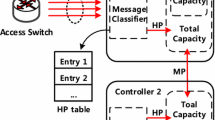Abstract
Today’s telecommunications networks are moving towards full convergence of voice and data services as well as seamless access via mobile and fixed networks. This implies a transformation of the underlying transport network technology (moving towards IP) as well as the way that transport resources can be shared across multiple applications and controlled from the intelligence domain. This paper provides an overview of admission control and resource reservation concepts and techniques for session-based applications to drive transport network resources. It also provides a brief description of the connectivity resources architecture being developed in BT, as well as the different functional architectures being proposed by the main standards bodies and industry organisations working in this area.
Similar content being viewed by others
References
Johnson D M: ‘QoS control versus generous dimensioning’, BT Technol J, 23, No2, pp 81–96 (April 2005).
IETF RFC3261: ‘SIP: session initiation protocol’, (2002).
Third Generation Partnership Project (3GPP) — http://www.3gpp.org/
Third Generation Partnership Project II (3GPP2) — http://www.3gpp2.org/
MultiService Forum — http://www.msforum.org/
ETSI: ‘Telecoms and Internet converged Services and Protocols for Advanced Networks (TISPAN)’ — http://portal.etsi.org
IETF RFC3312: ‘Integration of Resource Management and Session Initiation Protocol (SIP)’, (2002).
IETF RFC3313: ‘Private Session Initiation Protocol (SIP) Extensions for Media Authorisation’, (2003).
TS 23.207: ‘End-to-end Quality of Service (QoS) concept and architecture (Release 6)’, (2001).
IETF RFC2753: ‘A Framework for Policy-based Admission Control’, (2000).
Clark J and McDonald J: ‘An introduction to policy management’, BT Technol J, 23, No2, pp 118–129 (April 2005).
TS 29.209: ‘Policy control over Gq interface’, (2004).
TS 29.207: ‘Policy control over Go interface’, (2004).
TISPAN: ‘NGN Functional Architecture: Release 1. ES 2xxxxx v〈1.1.0〉. WI (DES/TISPAN-02007-eNGN)’, (2003).
TISPAN: ‘NGN Functional Architecture: Resource and Admission Control Subsystem (RACS); Release 1. ES2xxxxx v〈1.1.0〉. WI (DES/TISPAN-02020-eNGN)’, (2004).
DSL Forum: ‘TR-058: Multiservice Architecture and Framework Requirements’, (2003).
DSL Forum: ‘Working Text 102: Service Interface Requirements for TR-058 architectures’, (2004).
DSL Forum: ‘Working Text 069: CPE WAN Management Protocol’, (2004).
MSF-TR-QoS-001-FINAL: ‘Quality of Service for Next Generation Voice over IP networks’, (2003).
Ward R: ‘Setting industry direction — the role of the MultiService Forum’, BT Technol J, 23, No1, pp 160–172 (January 2005).
About this article
Cite this article
Cuevas, M. Admission control and resource reservation for session-based applications in next generation networks. BT Technol J 23, 130–145 (2005). https://doi.org/10.1007/s10550-005-0012-7
Issue Date:
DOI: https://doi.org/10.1007/s10550-005-0012-7




